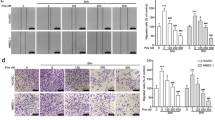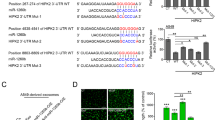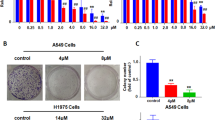Abstract
Nonsteroidal anti-inflammatory drugs (NSAIDs) are known to exert anti-angiogenic and anti-metastatic activity both in vitro and in vivo. Block of angiogenesis and metastasis by NSAIDs has been found to be mediated partly via suppression of matrix metalloproteinase (MMP) activity. However, the molecular mechanism of this inhibitory action has not been well defined. Recent works demonstrated that a membrane-anchored MMP inhibitor RECK may potently suppress MMP-2 and -9 activity to inhibit angiogenesis and metastasis in vitro and in vivo. In this study, we test the possibility that NSAIDs may up-regulate RECK to inhibit MMP activity. RT–PCR analyses showed that NS398 and aspirin up-regulated RECK mRNA level in CL-1 human lung cancer cells. Additionally, NSAIDs increased RECK protein level as detected by immunoblotting. Since RECK is a membrane-anchored glycoprotein, we also performed immunofluorescent staining to assess the expression of RECK on cell surface. Our results showed that fluorescent intensity of RECK was obviously increased after NSAID treatment. Moreover, induction of RECK by NSAIDs was associated with reduction of MMP-2 activity. We also found that NSAID-activated RECK expression might not be mediated via inhibition of cyclo-oxygenases (COXs) because addition of prostaglandin E2 (PGE2) could not counteract the effect of NSAIDs and overexpression of COX-2 could not down-regulate RECK. Taken together, our results suggest that induction of RECK expression may be one of the mechanisms by which NSAIDs suppress MMP activity to block angiogenesis and metastasis.
This is a preview of subscription content, access via your institution
Access options
Subscribe to this journal
Receive 50 print issues and online access
$259.00 per year
only $5.18 per issue
Buy this article
- Purchase on Springer Link
- Instant access to full article PDF
Prices may be subject to local taxes which are calculated during checkout




Similar content being viewed by others
References
Akhmedkhanov A, Toniolo P, Zeleniuch-Jacquotte A, Koenig KL, Shore RE . 2002 Br. J. Cancer 87: 49–53
Birkedal-Hansen H . 1995 Curr. Opin. Cell. Biol. 7: 728–735
Brew K, Dinakarpandian D, Nagase H . 2000 Biochim. Biophys. Acta 1477: 267–283
Chen JW, Peck K, Hong TM, Yang SC, Sher YP, Shih JY, Wu R, Cheng JL, Roffler SR, Wu CW, Yang PC . 2001 Cancer Res. 61: 5223–5230
Chu YW, Yang PC, Yang SC, Shyu YC, Hendrix MJC, Wu R, Wu CW . 1997 Am. J. Resir. Cell Mol. Biol. 17: 353–360
Ellerbroek SM, Stack MS . 1999 Bioassays 21: 940–949
Frantz B, O'Neill EA . 1995 Science 270: 2017–2019
Furumoto K, Arii S, Mori A, Furuyama H, Gorrin Rivas MJ, Nakao T, Isobe N, Murata T, Takahashi C, Noda M, Imamura M . 2001 Hepatology 33: 189–195
Futaki N, Arai I, Hamasaka Y, Takahashi S, Highchi S, Otomo S . 1993 J. Pharm. Pharmacol. 45: 753–755
Kitayama H, Sugimoto Y, Matsuzaki T, Ikawa Y, Noda M . 1989 Cell 56: 77–84
Masferrer JL, Leahy KM, Koki AT, Zweifel BS, Settle SL, Mark Woerner SB, Edwards DA, Flickinger AG, Moore RJ, Seilbert K . 2000 Cancer Res. 60: 1306–1311
Meredith TJ, Vale JA . 1992 Therapeutic Applications of NSAIDs, Subpopulations and New Formulations Famaey JP and Paulus HE (eds) New York: Dekker pp 67–96
Nelson C . 1995 J. Natl. Cancer Inst. 87: 567–569
Oh J, Takahashi R, Kondo S, Mizoguchi A, Adachi E, Sasahara RM, Nishimura S, Imamura Y, Kitayama H, Alexander DB, Ide C, Horan TP, Arakawa T, Yoshida H, Nishikawa S, Itoh Y, Seiki M, Itohara S, Takahashi C, Noda M . 2001 Cell 107: 789–800
Pan MR, Chuang LY, Hung WC . 2001 FEBS Lett. 508: 365–368
Pan MR, Hung WC . 2002 J. Biol. Chem. 277: 32775–32780
Rozic JG, Chakraborty C, Lala PK . 2001 Int. J. Cancer 93: 497–506
Sasahara RM, Takahashi C, Noda M . 1999 Biochem. Biophys. Res. Commun. 264: 668–675
Schreinemachers DM, Everson RB . 1994 Epidermiology 5: 138–146
Sternlicht MD, Werb Z . 2001 Annu. Rev. Cell Dev. Biol. 17: 463–516
Takahashi C, Sheng Z, Horan TP, Kitayama H, Maki M, Hitomi K, Kitaura Y, Takai S, Sasahara RM, Horimoto A, Ikawa Y, Ratzkin BJ, Arakawa T, Noda M . 1998 Proc. Natl. Acad. Sci. USA 95: 13221–13226
Tsujii M, DuBois RN . 1995 Cell 83: 493–501
Vu TH, Werb Z . 2000 Genes Dev. 14: 2123–2133
Acknowledgements
We thank Dr ML Kuo for providing the experimental materials. This work was supported by the grant NSC 91-2320-B-037-015.
Author information
Authors and Affiliations
Corresponding author
Rights and permissions
About this article
Cite this article
Liu, LT., Chang, HC., Chiang, LC. et al. Induction of RECK by nonsteroidal anti-inflammatory drugs in lung cancer cells. Oncogene 21, 8347–8350 (2002). https://doi.org/10.1038/sj.onc.1206017
Received:
Revised:
Accepted:
Published:
Issue Date:
DOI: https://doi.org/10.1038/sj.onc.1206017
Keywords
This article is cited by
-
Downregulation of reversion-inducing-cysteine-rich protein with Kazal motifs (RECK) is associated with enhanced expression of matrix metalloproteinases and cholangiocarcinoma metastases
Journal of Gastroenterology (2011)
-
RECK—a newly discovered inhibitor of metastasis with prognostic significance in multiple forms of cancer
Cancer and Metastasis Reviews (2007)
-
Cooperative effects of matrix metalloproteinase and cyclooxygenase-2 inhibition on intestinal adenoma reduction
British Journal of Cancer (2003)



